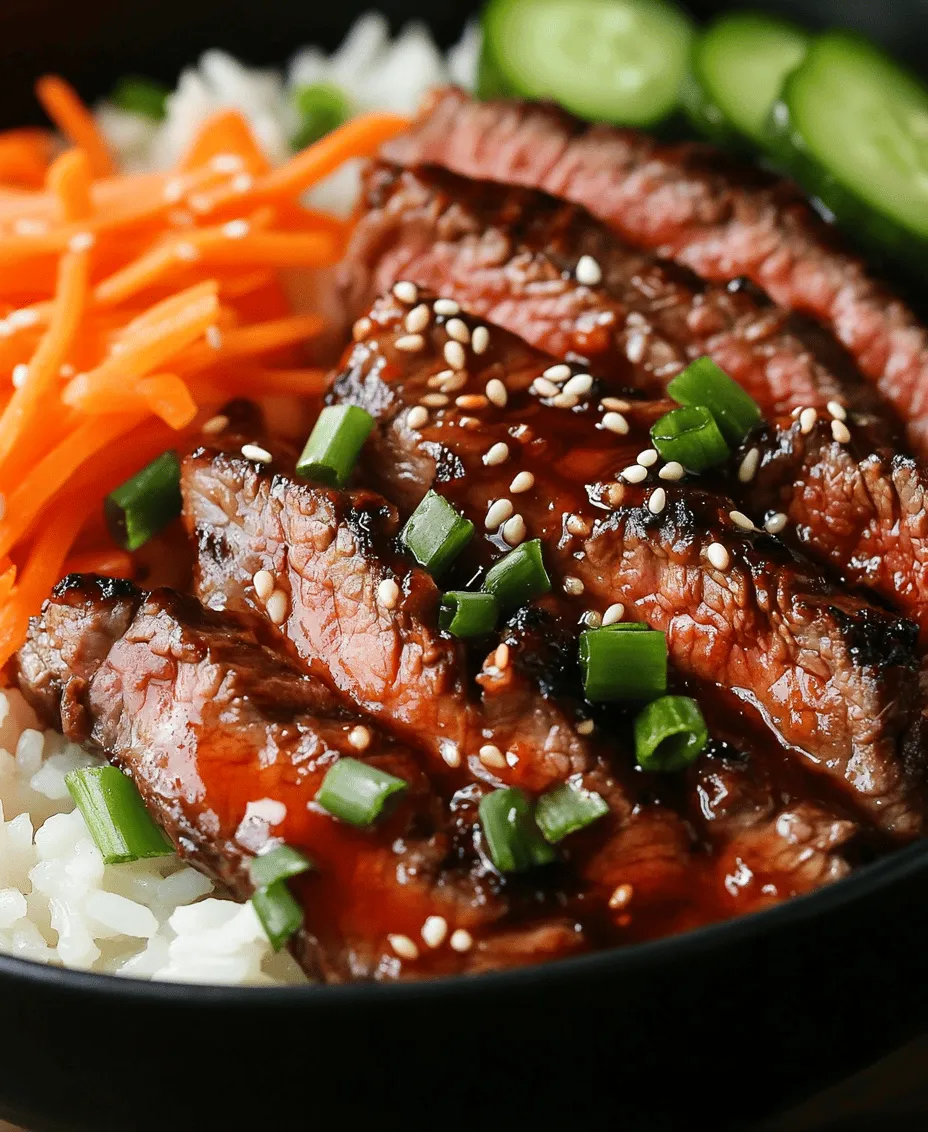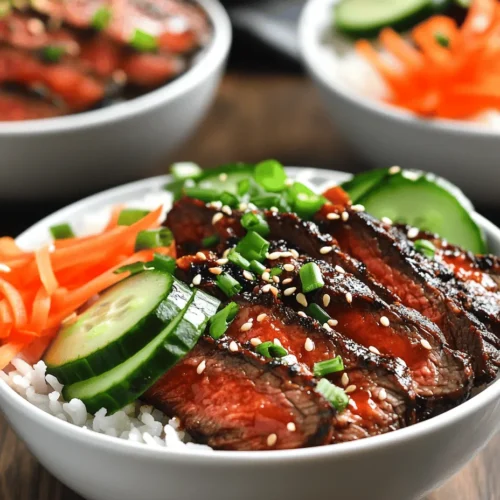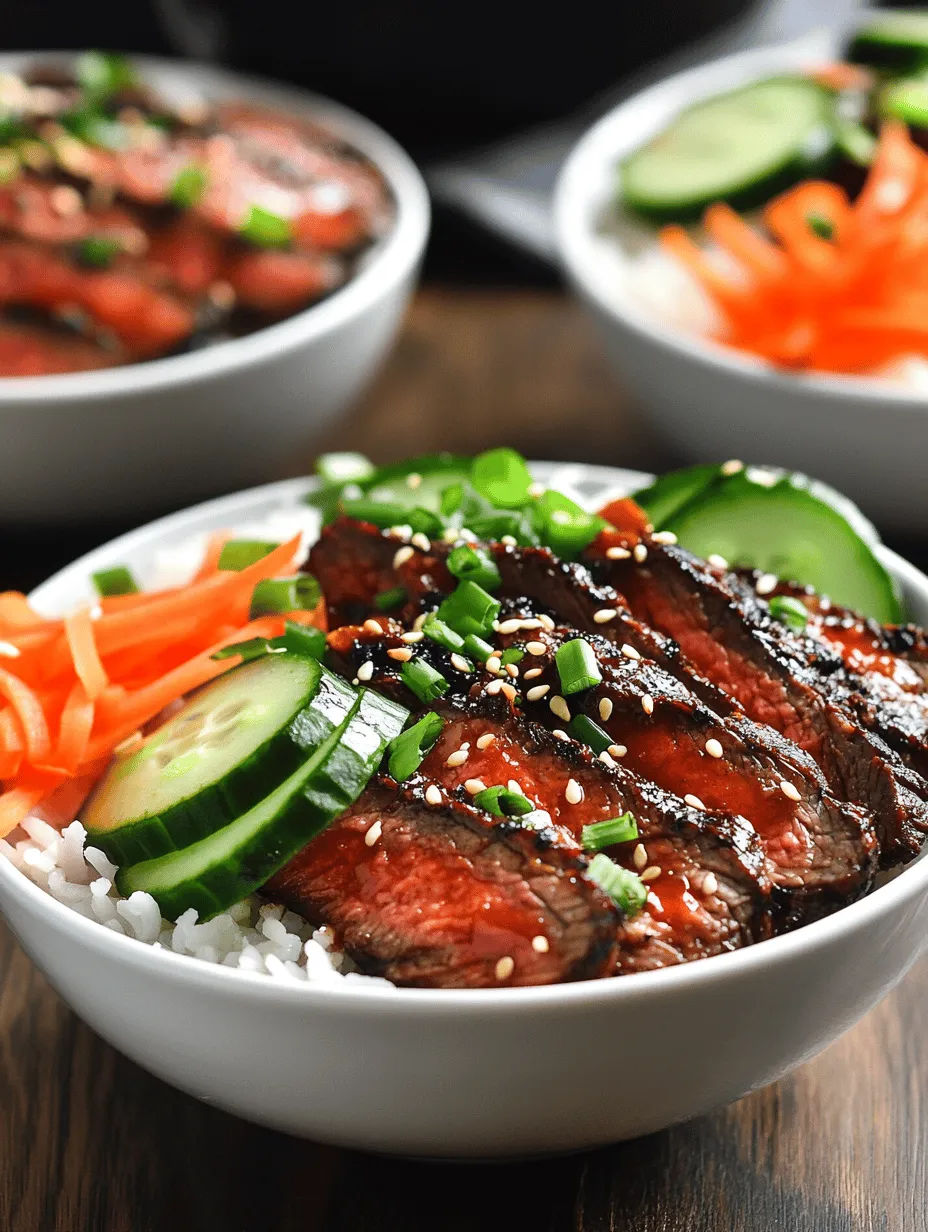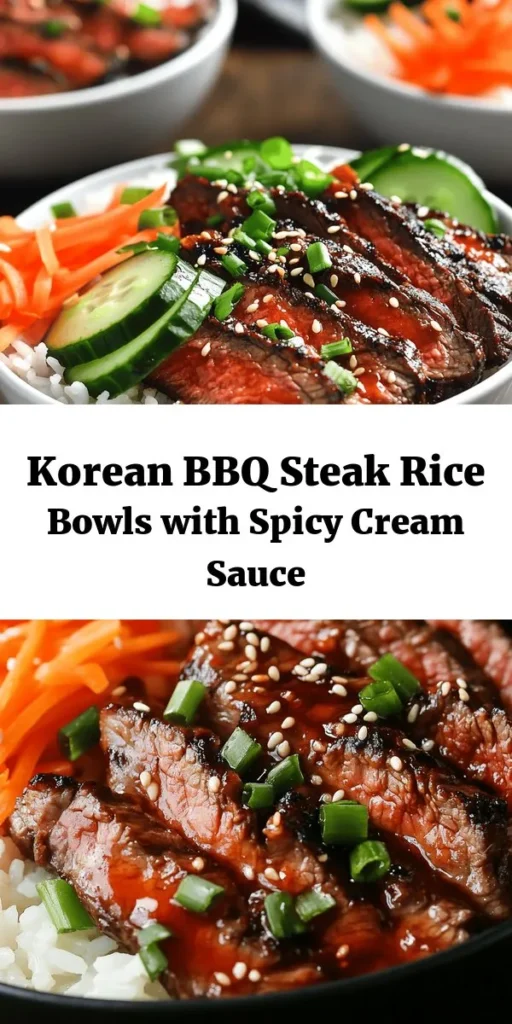Introduction
Korean cuisine has been gaining immense popularity around the world, captivating food lovers with its vibrant flavors and unique combinations. From the tantalizing sweetness of bulgogi to the fiery kick of kimchi, Korean dishes offer a delightful palate experience that resonates with many. One such dish that exemplifies this trend is the Korean BBQ Steak Rice Bowl with Spicy Cream Sauce.
This dish is not just about the steak; it’s a harmonious blend of tender marinated beef, fresh vegetables, and aromatic rice, all brought together by a creamy, spicy sauce that elevates every bite. The balance of savory, spicy, and sweet flavors, coupled with a variety of textures—from the crunch of fresh vegetables to the tenderness of the steak—makes this dish a favorite for both casual dinners and special occasions.
In this article, we aim to guide you through the process of preparing these delicious Korean BBQ Steak Rice Bowls at home. Whether you’re a seasoned cook or a beginner in the kitchen, our step-by-step instructions will help you create a mouth-watering meal that’s sure to impress.
Understanding the Key Ingredients
To achieve the authentic taste of Korean BBQ Steak Rice Bowls, it’s essential to understand the key ingredients that make this dish shine. Each component plays a vital role in creating the overall flavor profile.
Flank Steak or Ribeye: Choosing the Right Cut for Tenderness
The star of this dish is undoubtedly the steak. Flank steak and ribeye are two popular cuts that work beautifully for this recipe. Flank steak is lean yet full of flavor, making it a great choice for marinating. Ribeye, on the other hand, is more marbled with fat, resulting in a richer, juicier bite. Depending on your preference for tenderness and flavor, you can choose either cut for your Korean BBQ Steak Bowl.
Soy Sauce and Sesame Oil: Importance in Korean Flavor Profiles
No Korean dish is complete without soy sauce and sesame oil. Soy sauce provides a deep umami flavor that enhances the taste of the steak and vegetables. It also contributes to the dish’s rich color. Sesame oil, with its nutty aroma, adds a distinct depth that is quintessential in Korean cuisine. These ingredients are not just seasonings; they are the backbone of many Korean dishes, imparting a signature taste that is both savory and satisfying.
Gochujang: The Backbone of Authentic Korean Spice
Gochujang, a fermented Korean chili paste, is an essential ingredient that brings heat and flavor to the dish. It is made from red chili powder, glutinous rice, fermented soybeans, and salt, resulting in a sweet and spicy flavor profile that is unique to Korean cooking. This ingredient not only adds spice but also a hint of sweetness, making it perfect for balancing the richness of the steak and the creaminess of the sauce.
Fresh Vegetables: Cucumber and Carrots for Crunch and Freshness
To complement the rich flavors of the steak, fresh vegetables are essential. Thinly sliced cucumbers and julienned carrots provide a refreshing crunch that contrasts beautifully with the tender meat. These vegetables not only add texture but also enhance the visual appeal of the dish, making it as pleasing to the eyes as it is to the palate.
Jasmine Rice: The Perfect Base for the Bowl
Finally, jasmine rice serves as the ideal base for your Korean BBQ Steak Bowl. Its fragrant aroma and slightly sticky texture make it perfect for holding together the various components of the dish. Jasmine rice is also naturally soft and fluffy, allowing it to absorb the flavors of the marinade and sauce, ensuring each bite is bursting with taste.
Marinating the Steak
Marinating is a crucial step in preparing the steak for your Korean BBQ Rice Bowl. It enhances the flavors and tenderizes the meat, resulting in a juicy and flavorful dish.
Importance of Marinating: Enhancing Flavor and Tenderness
The process of marinating involves soaking the steak in a mixture of ingredients that penetrate the meat, infusing it with flavor while also breaking down its fibers for improved tenderness. The key to a successful marinade is balancing the flavors and ensuring enough time is allowed for the meat to absorb them.
Detailed Breakdown of the Marinade Ingredients
To create the perfect marinade for your steak, you’ll need the following ingredients:
– Soy Sauce: This ingredient is essential for imparting umami and depth to the meat.
– Brown Sugar: The addition of brown sugar helps in caramelization during cooking, providing a sweet contrast to the savory soy sauce.
– Rice Vinegar: This ingredient adds a touch of acidity, helping to balance the flavors and tenderize the meat further.
– Garlic and Ginger: These aromatics are staples in Korean cooking. They provide a warm, savory flavor that enhances the overall profile of the steak.
Step-by-Step Guide to Marinating the Steak
1. Prepare the Marinade: In a medium bowl, combine 1/4 cup of soy sauce, 2 tablespoons of brown sugar, 2 tablespoons of rice vinegar, 3 cloves of minced garlic, and 1 tablespoon of freshly grated ginger. Whisk until the sugar is dissolved and all ingredients are well mixed.
2. Trim the Steak: If using flank steak, remove any excess fat and slice it against the grain into thin strips. If using ribeye, you can marinate it whole or slice it into strips, depending on your preference.
3. Marinate: Place the steak pieces into a resealable plastic bag or a shallow dish. Pour the marinade over the steak, ensuring it is well coated. Seal the bag or cover the dish and refrigerate.
4. Marinating Time: For optimal flavor, let the steak marinate for at least 30 minutes. For more intense flavor, you can marinate it for up to 4 hours. Avoid marinating for too long, as the acid in the marinade can break down the meat too much, resulting in a mushy texture.
Recommended Marinating Times and Tips for Best Results
– 30 Minutes: Ideal for a quick meal; the steak will still absorb some flavor.
– 1-2 Hours: Provides a good balance of flavor and tenderness.
– Up to 4 Hours: The best option for maximum flavor infusion.
For best results, always marinate in the refrigerator to prevent bacterial growth. When ready to cook, remove the steak from the marinade and allow it to come to room temperature for about 15 minutes. This step helps in achieving a more even cooking result.
Crafting the Spicy Cream Sauce
The spicy cream sauce is what truly brings this dish together, adding a creamy, zesty kick that enhances the overall flavor profile.
Explanation of the Role of the Spicy Cream Sauce in the Dish
The spicy cream sauce not only adds richness to the rice bowl but also complements the savory flavors of the marinated steak and the freshness of the vegetables. Its unique combination of creaminess and spice creates a delightful contrast, making every bite a flavorful experience.
Ingredients Breakdown
To prepare the spicy cream sauce, you will need:
– Mayonnaise: This will form the creamy base of the sauce, providing a rich texture that coats the steak and rice beautifully.
– Gochujang: This ingredient is the star of the sauce, providing heat and a depth of flavor that is characteristic of Korean cuisine. The sweetness of the gochujang also balances the creaminess of the mayonnaise, resulting in a well-rounded sauce.
By combining these ingredients, you’ll create a sauce that is both delicious and versatile, perfect for drizzling over your rice bowls and even as a dip for extra vegetables.
As you prepare this dish, embrace the vibrant flavors and textures that Korean cuisine has to offer. The combination of marinated steak, fresh vegetables, and a spicy cream sauce makes for a meal that is satisfying, delicious, and perfect for any occasion. In the next part of this article, we will dive into the cooking process, including how to grill the steak to perfection and assemble your Korean BBQ Steak Rice Bowls. Stay tuned for the exciting continuation of this culinary journey!

Lime Juice for Brightness
Incorporating lime juice into your Korean BBQ steak rice bowls is essential for adding a bright and zesty flavor that complements the richness of the steak and the creamy sauce. The acidity from the lime juice helps to balance the dish, enhancing the overall taste profile. When selecting limes, look for those that are firm and slightly heavy for their size, as they tend to be juicier.
To prepare the lime juice, simply cut the lime in half and squeeze the juice into a small bowl, ensuring to remove any seeds. You can adjust the amount of lime juice according to your preference; usually, the juice from one lime should suffice for a recipe serving four. This citrus touch will elevate the flavors and provide a refreshing contrast to the savory components of the dish.
Instructions for Preparing the Sauce
Creating the spicy cream sauce is a straightforward process that significantly enhances your Korean BBQ steak rice bowls. Here’s how to make it:
1. Gather Your Ingredients: You will need mayonnaise, gochujang (Korean chili paste), lime juice, and a pinch of sugar.
2. Mix the Base: In a medium bowl, combine 1 cup of mayonnaise with 2 tablespoons of gochujang. The gochujang not only adds spice but also a deep umami flavor.
3. Add Lime Juice: Stir in the freshly squeezed lime juice, adjusting the quantity based on your spice tolerance.
4. Sweeten the Sauce: Add a teaspoon of sugar to balance the heat from the gochujang. Mix all the ingredients until smooth and well combined.
5. Taste and Adjust: Before serving, taste the sauce and adjust any ingredients to your liking. If you want more heat, add a little more gochujang; if you prefer it creamier, add more mayonnaise.
This spicy cream sauce can be made in advance and stored in the refrigerator for up to a week, allowing the flavors to meld together beautifully.
Tips on Adjusting Spice Levels to Personal Preference
One of the best aspects of making Korean BBQ steak rice bowls is the ability to customize the spice levels to suit your taste. Here are a few tips:
– Start Small: If you’re not accustomed to spicy foods, start with a small amount of gochujang and gradually increase it until you reach your desired heat level.
– Add Other Ingredients: If the sauce becomes too spicy, you can balance it out with additional mayonnaise or a touch of honey for sweetness.
– Garnishes: Consider adding mild toppings like cucumber slices or avocado, which can help cool the palate.
– Taste as You Go: Always taste your sauce and adjust as needed. Keeping lime juice handy can also help counteract any excessive heat.
Cooking the Steak to Perfection
Cooking the steak perfectly is crucial for achieving the best flavor and texture in your Korean BBQ steak rice bowls. Here’s how to do it right:
Best Practices for Cooking Steak
1. Choosing the Right Cooking Method: You can use a skillet or a grill pan for cooking your steak. A grill pan will give you those lovely char marks, while a skillet can provide a better sear. Both methods work well, so choose based on what equipment you have available.
2. Importance of High Heat for Caramelization: Regardless of the cooking method, ensure that your cooking surface is preheated to high heat. This step is vital for achieving a beautiful caramelization on the steak, which enhances flavor.
3. Timing and Technique for Achieving Desired Doneness:
– Medium-Rare: Cook for about 3-4 minutes on each side.
– Medium: Target 4-5 minutes per side.
– Medium-Well: Cook for 5-6 minutes on each side.
– Use a meat thermometer to check the internal temperature: 130°F for medium-rare, 140°F for medium, and 150°F for medium-well.
4. Tips for Resting the Steak to Retain Juices: After cooking, allow the steak to rest for at least 5 minutes before slicing. This resting period lets the juices redistribute throughout the meat, ensuring a juicy, tender result.
Assembling the Rice Bowls
Now that your steak is cooked to perfection and your spicy cream sauce is ready, it’s time to assemble your rice bowls. Here’s a step-by-step guide:
1. Start with the Base: Begin by placing a generous scoop of steamed jasmine rice or brown rice at the bottom of each bowl. Rice serves as the foundation of the dish, so make sure it’s fluffy and well-cooked.
2. Layer the Steak: Slice your rested steak against the grain into thin strips and arrange them on top of the rice. This not only enhances tenderness but also makes for a beautifully presented bowl.
3. Add Vegetables: Include a variety of colorful vegetables such as shredded carrots, sliced cucumbers, and bell peppers. These not only add flavor but also contribute to the visual appeal of the dish.
4. Drizzle the Sauce: Generously drizzle the spicy cream sauce over the top of the steak and vegetables. This step brings all the flavors together and adds a creamy texture.
5. Garnish: Finish off your rice bowls with sesame seeds and sliced green onions for a fresh crunch and flavor boost.
Suggestions for Customizing the Bowls
Feel free to customize your rice bowls based on personal preferences. Here are some ideas:
– Different Proteins: Substitute steak with grilled chicken or tofu for a vegetarian option.
– Extra Toppings: Add sliced avocado, pickled radishes, or even a soft-boiled egg for added richness.
– Sauce Variations: Experiment with different sauces like teriyaki or peanut sauce if you want to mix things up.
Visual Appeal: The Importance of Color and Texture in the Final Presentation
When assembling your rice bowls, consider the visual appeal. Aim for a balance of colors and textures, as this makes the dish more inviting. Bright greens from vegetables, the rich browns of steak, and the white rice create a beautiful contrast. Additionally, arranging the ingredients in a way that showcases each element can elevate the overall presentation.
Finishing Touches and Garnishing
The finishing touches can make a significant difference in the appearance and taste of your Korean BBQ steak rice bowls. Here’s how to enhance your dish:
Explanation of the Garnishes Used
1. Sesame Seeds for Crunch: Toasted sesame seeds add a nutty flavor and delightful crunch. Sprinkle them over the top just before serving.
2. Green Onions for Freshness: Sliced green onions not only provide a pop of color but also add a fresh, mild onion flavor that contrasts beautifully with the richness of the dish.
Tips on How to Garnish for an Appealing Look
– Strategic Placement: When garnishing, be strategic about placement. Scatter sesame seeds and green onions evenly for a balanced look.
– Use Fresh Ingredients: Always opt for fresh garnishes, as wilted or dull toppings can detract from the overall presentation.
Importance of the Final Drizzle of Spicy Cream Sauce
Don’t forget the final drizzle of spicy cream sauce over the assembled bowls. This last touch not only adds flavor but also creates an inviting visual of creamy swirls atop the vibrant ingredients.
Serving Suggestions
Korean BBQ steak rice bowls are versatile and perfect for various occasions. Here are some serving suggestions:
Ideal Occasions for Serving Korean BBQ Steak Rice Bowls
– Family Dinners: These rice bowls make for a satisfying meal that can be enjoyed by the whole family.
– Casual Gatherings: Serve them at potlucks or casual get-togethers, allowing guests to assemble their bowls with their preferred toppings.
– Meal Prep: These bowls are perfect for meal prep, as they can be made in advance and stored in the fridge for quick lunches.
Pairing Suggestions: What Drinks or Sides Complement the Dish
– Drinks: Pair your rice bowls with a refreshing iced tea or a light beer. For a non-alcoholic option, try sparkling water with a slice of lime.
– Sides: Serve with a side of kimchi or a simple cucumber salad to enhance the meal’s flavor profile.
Storing Leftovers: Best Practices for Maintaining Flavor and Texture
If you have leftovers, store them in airtight containers in the refrigerator. For optimal flavor and texture, keep the sauce separate until you’re ready to enjoy the leftovers. Reheat the rice and steak gently in the microwave, adding a splash of water to prevent drying out.
Conclusion
Korean BBQ steak rice bowls are not just a meal; they are an experience that captures the essence of homemade Korean cuisine. The combination of marinated steak, colorful vegetables, and the spicy cream sauce creates a symphony of flavors that is sure to satisfy.
By trying this recipe, you embark on a culinary adventure that allows you to explore the diverse world of Korean flavors. Cooking at home not only gives you the opportunity to control the ingredients but also allows you to share delicious meals with your loved ones.
So, gather your ingredients, unleash your inner chef, and enjoy the joy of cooking and sharing a delightful dish that brings everyone together. The satisfaction of a well-prepared meal is unparalleled, and these Korean BBQ steak rice bowls are sure to become a favorite in your household.



